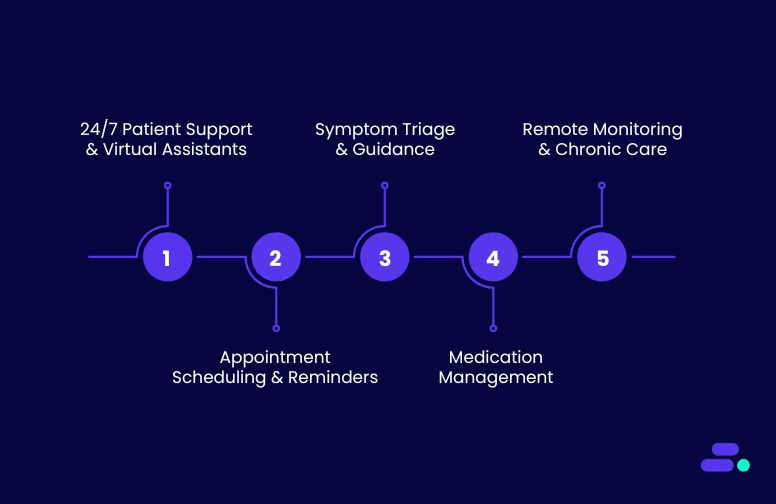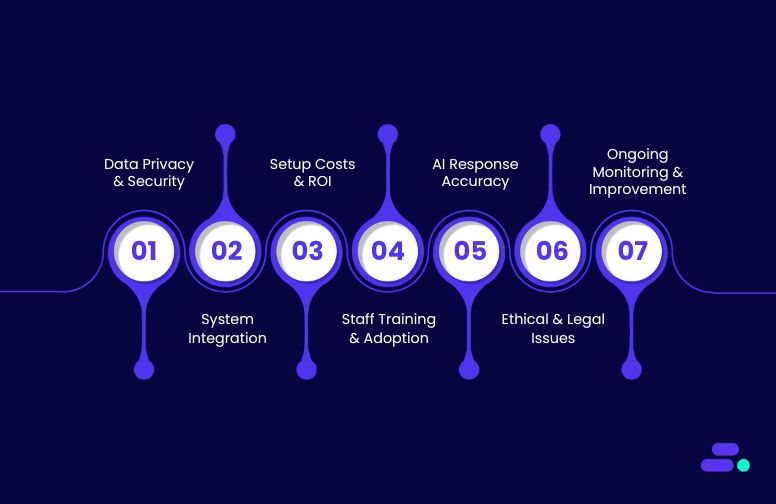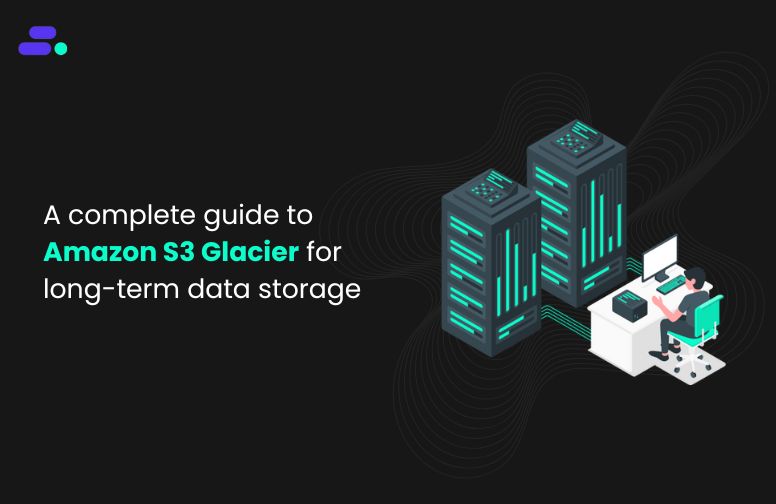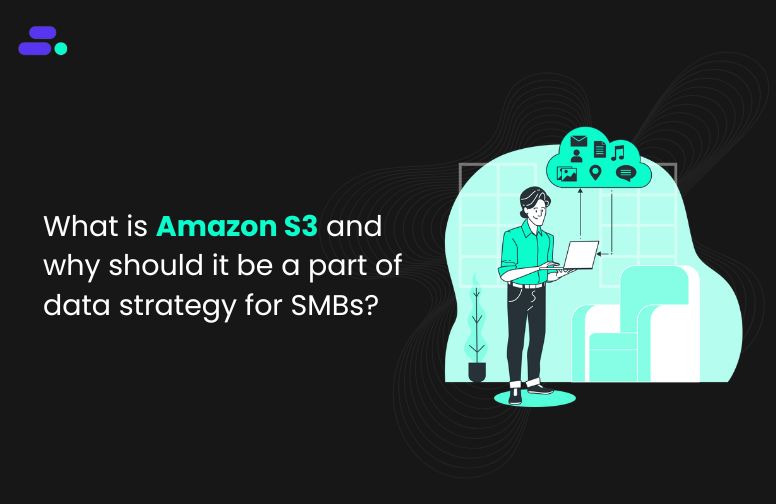This is a div block with a Webflow interaction that will be triggered when the heading is in the view.

Modernize your cloud. Maximize business impact.
There was a time when businesses had to invest heavily in servers, storage, and IT staff just to keep operations running. Scaling up meant buying more hardware, and adapting to market changes was a slow, expensive process. That is no longer the case with cloud computing. Today, SMBs can access enterprise-grade infrastructure on demand, pay only for what they use, and scale in minutes instead of months.
Take the example of a regional retailer competing with a legacy chain still tied to on-prem systems. The legacy player spends weeks setting up servers and testing software before launching a seasonal campaign. The cloud-enabled SMB spins up AWS resources in hours, integrates with modern e-commerce tools, and auto-scales during traffic spikes, going live in days. Cloud computing doesn’t just level the playing field, it gives SMBs the agility and speed to outpace their larger, slower-moving competitors.
This guide breaks down the core cloud computing models and deployment types every SMB should understand to unlock agility, scalability, and cost efficiency.
Key takeaways:
- The right cloud deployment model depends on SMB needs for compliance, workload, and growth.
- Knowing IaaS, PaaS, SaaS, and FaaS helps SMBs choose the best service for control and speed.
- Cloud computing lets SMBs compete with legacy firms through faster innovation and scaling.
- Customized cloud strategies align tech choices with SMB goals for maximum impact.
- Cloudtech’s expertise helps SMBs pick and deploy cloud models confidently and cost-effectively.
How does cloud computing help SMBs outpace larger competitors?
Without cloud computing, SMBs often face the same limitations that have held them back for decades, including slow technology rollouts, high upfront costs, and infrastructure that struggles to scale with demand. Competing against larger companies in this environment means constantly playing catch-up, as enterprise competitors can outspend and out-resource them at every step.
Cloud computing flips that dynamic. Instead of sinking capital into hardware, maintenance, and long deployment cycles, SMBs can rent exactly what they need, when they need it, from powerful computing instances to advanced AI models. This agility turns what used to be multi-year IT initiatives into projects that can be delivered in weeks.
Consider the difference in launching a new product:
- Without cloud: Procuring servers, configuring systems, hiring additional IT staff, and testing environments can stretch timelines for months, while larger competitors with established infrastructure move faster.
- With cloud: Infrastructure is provisioned in minutes, applications scale automatically, and global delivery is possible from day one, allowing SMBs to meet market demand the moment it arises.
In practice, this means smaller businesses can handle traffic surges without overbuying resources. AI, analytics, security, and global content delivery comes at a fraction of the cost. Businesses can focus on innovation instead of upkeep, letting cloud providers like AWS and their partners like Cloudtech handle maintenance, uptime, and redundancy.
In short, cloud computing removes the “infrastructure gap” that used to give large corporations an unshakable advantage. It breaks the traditional advantage of big budgets.
Take a 15-person e-commerce startup. By using AWS global infrastructure, they can launch a worldwide shipping option within two months, using services like Amazon CloudFront for faster content delivery and Amazon RDS for scalable databases. Meanwhile, a traditional retail giant with its own data centers spends over a year just upgrading its logistics software for international orders.
Cloud computing as a growth multiplier: The real power of cloud computing for SMBs isn’t just cost savings, it’s acceleration. Cloud tools enable:
- Data-driven decision-making: Real-time analytics for faster, smarter choices.
- Access to new markets: Multi-region deployments without physical offices.
- Customer experience upgrades: Always-on services with minimal downtime.
When SMBs combine the speed of innovation with intelligent use of cloud tools, they can compete head-to-head with much larger, better-funded rivals and often win.

The four cloud paths: Which one will take SMBs the furthest?
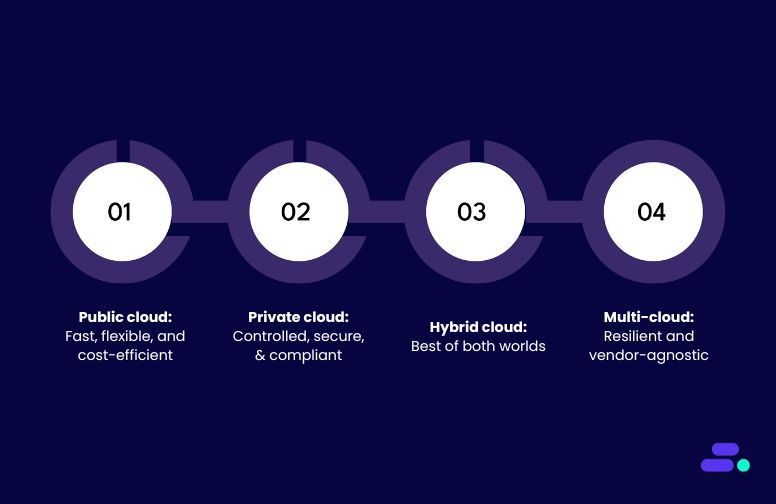
Adopting cloud computing isn’t just about moving to the cloud, but about moving in the right way. The deployment model businesses choose determines how well the cloud environment will align with their business needs, budget, compliance requirements, and growth plans.
For SMBs, the wrong choice can mean underutilized resources, higher-than-expected costs, or compliance risks. The right choice, on the other hand, can unlock faster product launches, better customer experiences, and a competitive edge against much larger rivals.
Each of the four primary cloud paths, including public, private, hybrid, and multi-cloud, comes with its own strengths and trade-offs. Selecting the right one requires balancing cost efficiency, security, performance, and future scalability so their cloud journey is not only smooth today but also sustainable in the long run.
1. Public cloud: Fast, flexible, and cost-efficient
In a public cloud model, computing resources such as servers, storage, and networking are hosted and managed by a third-party cloud provider (like AWS) and shared across multiple customers. Each business accesses its own isolated slice of these shared resources via the internet, paying only for what it actually uses.
The public cloud eliminates the need to purchase, install, and maintain physical IT infrastructure. This means no more waiting weeks for hardware procurement or struggling with capacity planning. Instead, SMBs can provision new virtual servers, storage, or databases in minutes through AWS services such as:
- Amazon EC2 for on-demand compute power
- Amazon S3 for highly scalable, secure storage
- Amazon RDS for fully managed relational databases
- Amazon CloudFront for fast, global content delivery
The cost model is equally attractive, since public cloud is typically pay-as-you-go with no long-term commitments, enabling SMBs to experiment with new ideas without a large upfront investment.
Public cloud is a natural fit for SMBs that:
- Have minimal regulatory compliance requirements
- Operate primarily with cloud-native or modernized applications
- Experience fluctuating demand and want to scale resources up or down quickly
- Prefer to focus on business innovation rather than infrastructure maintenance
Digital marketing agencies, SaaS startups, e-commerce brands, or online education platforms benefit the most from public cloud.
Example in action: A digital marketing agency running campaigns across multiple countries sees demand surge during events like Black Friday. With AWS, it can quickly spin up Amazon EC2 instances to handle traffic spikes, store and analyze massive datasets in Amazon S3, and deliver rich media ads via Amazon CloudFront with minimal latency.
After the peak, resources are scaled back, keeping costs predictable and aligned with revenue. This agility not only saves money but also speeds time to market, enabling SMBs to compete with far larger, slower-moving competitors still reliant on on-premise infrastructure.
2. Private cloud: Controlled, secure, and compliant
In a private cloud model, all computing resources, including servers, storage, and networking are dedicated exclusively to a single organization. This can be hosted in the SMB’s own data center or managed by a third-party provider using isolated infrastructure. Unlike the shared nature of the public cloud, private cloud environments offer complete control over configuration, data governance, and security policies.
For SMBs operating in highly regulated industries such as healthcare, finance, or legal services, a private cloud ensures compliance with standards like HIPAA, PCI DSS, or GDPR. It also allows integration with legacy systems that may not be cloud-ready but must still meet strict security requirements.
With AWS, SMBs can build a secure and compliant private cloud using services such as:
- AWS Outposts for running AWS infrastructure and services on-premises with full cloud integration
- Amazon VPC for creating logically isolated networks in the AWS cloud
- AWS Direct Connect for dedicated, high-bandwidth connectivity between on-premises environments and AWS
- AWS Key Management Service (KMS) for centralized encryption key control
- AWS Config for compliance tracking and governance automation
The private cloud model enables predictable performance, tighter security controls, and tailored infrastructure optimization, ideal for workloads involving sensitive customer data or mission-critical applications.
Private cloud is a natural fit for SMBs that:
- Operate in regulated industries requiring strict compliance (e.g., HIPAA, GDPR, PCI DSS)
- Need full control over infrastructure configuration and security policies
- Handle highly sensitive or confidential data
- Integrate closely with specialized or legacy systems that can’t be hosted in public cloud environments
Examples include regional banks, healthcare providers, legal firms, and government contractors.
Example in action: Imagine a regional healthcare provider managing electronic health records (EHR) for thousands of patients. Compliance with HIPAA means patient data must be encrypted, access-controlled, and stored in a secure, isolated environment. Using AWS Outposts, the provider can run workloads locally while maintaining seamless integration with AWS services for analytics and backup.
Amazon VPC ensures network isolation, AWS KMS handles encryption, and AWS Config continuously monitors compliance. This setup ensures the organization meets all regulatory obligations while benefiting from cloud scalability and automation, something a purely on-prem setup could achieve only with significant hardware investment and maintenance overhead.
3. Hybrid cloud: Best of both worlds
In a hybrid cloud model, SMBs combine on-premises infrastructure with public or private cloud environments, creating a unified system where workloads and data can move seamlessly between environments.
This approach is ideal for organizations that have made significant investments in legacy systems but want to tap into the scalability, innovation, and cost benefits of the cloud without a disruptive “all-at-once” migration.
With AWS, SMBs can extend their existing infrastructure using services such as:
- AWS Direct Connect for secure, low-latency connections between on-prem systems and AWS.
- Amazon S3 for cost-effective cloud storage that integrates with local workloads.
- AWS Outposts to bring AWS infrastructure and services into the on-prem data center for consistent operations across environments.
- AWS Backup for centralized, policy-based backup across cloud and on-premises resources.
The private cloud offers predictable performance, stronger security, and tailored infrastructure, perfect for SMBs with sensitive data, strict compliance needs, or mission-critical workloads. Dedicated resources ensure control over compliance, data residency, and reliability.
Hybrid cloud is a strong fit for SMBs that:
- Still run business-critical legacy applications on-premises.
- Require certain workloads to remain local due to compliance or latency needs.
- Want to modernize incrementally to reduce risk and disruption.
- Need burst capacity in the cloud for seasonal or project-based demand.
Examples include SMBs from industries like manufacturing, logistics, or healthcare where on-site infrastructure is still essential.
Example in action: A manufacturing SMB runs its legacy ERP system on-premises for production scheduling and inventory management but uses AWS for analytics and AI-driven demand forecasting. Production data is synced to Amazon S3, where AWS Glue prepares it for analysis in Amazon Redshift.
Forecast results are then sent back to the ERP system, enabling smarter inventory purchasing without replacing the existing ERP. Over time, more workloads can move to AWS, giving the business the flexibility to modernize at its own pace while still leveraging its trusted on-prem infrastructure.
4. Multi-cloud: Resilient and vendor-agnostic
In a multi-cloud model, an SMB strategically uses services from two or more cloud providers such as AWS, Microsoft Azure, and Google Cloud, often selecting each based on its unique strengths. Instead of relying on a single vendor for all workloads, businesses distribute applications and data across multiple platforms to increase resilience, avoid vendor lock-in, and optimize for performance or cost in specific scenarios.
Multi-cloud enables SMBs to take advantage of the best features from each provider while mitigating the risk of outages or pricing changes from any single vendor. For example, an SMB might run customer-facing web apps on AWS for its global reach, store analytics data in Google Cloud’s BigQuery for its advanced querying, and use Azure’s AI services for niche machine learning capabilities.
AWS plays a central role in many multi-cloud strategies with services such as:
- Amazon EC2 for scalable, reliable compute capacity
- Amazon S3 for durable, cross-region object storage
- AWS Direct Connect for high-speed, secure connections between cloud providers and on-premises environments
- AWS Transit Gateway to simplify hybrid and multi-cloud networking
The cost model in multi-cloud depends on the provider mix, but SMBs gain negotiating power and flexibility, allowing them to select the most cost-effective or performant option for each workload.
Multi-cloud is a natural fit for SMBs that:
- Require high availability and disaster recovery across platforms
- Want to leverage specialized services from different providers
- Operate in industries where redundancy is critical (e.g., finance, healthcare, global SaaS)
- Aim to reduce dependency on a single vendor for strategic or cost reasons
Examples include fintech platforms, global SaaS companies, content delivery providers, or mission-critical logistics systems where downtime or vendor limitations can directly impact revenue and customer trust
Example in action: Consider a global SaaS platform that delivers real-time collaboration tools to clients across multiple continents. To ensure uninterrupted service, it hosts primary workloads on AWS using Amazon EC2 and Amazon RDS, but mirrors critical databases to Azure for failover. Large datasets are stored in Amazon S3 for durability, while select AI-driven analytics are processed in Google Cloud for speed and cost efficiency. If one provider experiences an outage or a regional performance issue, traffic can be rerouted within minutes, ensuring customers see no disruption.
This approach not only strengthens business continuity but also gives the company leverage to choose the best tools for each job, without being locked into a single ecosystem.
When selecting a cloud deployment model, SMB leaders should weigh cost, compliance, workload type, and future scalability.
Comparison table of cloud deployment models for SMBs:

Picking the right cloud level: Service models demystified
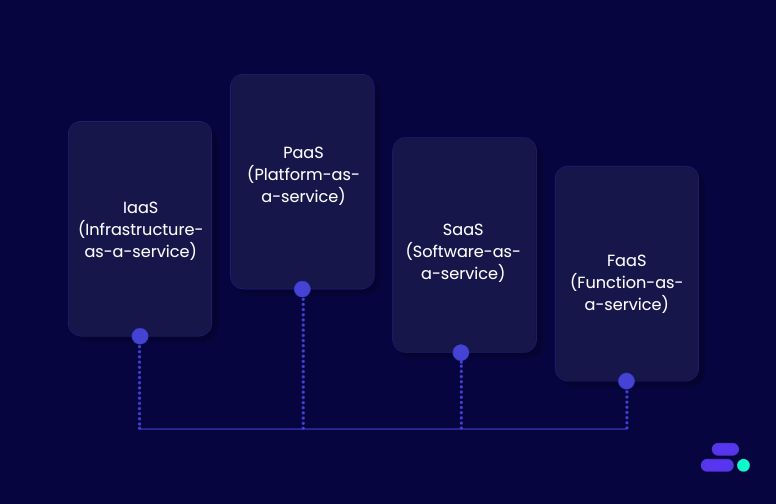
When SMBs move to the cloud, the decision isn’t just where to host workloads (public, private, hybrid, or multi-cloud), it’s also about how much control and responsibility they want over the underlying technology stack.
This is where cloud service models come in. Each model offers a different balance between flexibility, control, and simplicity, and choosing the right one can make the difference between smooth scaling and unnecessary complexity.
1. IaaS (Infrastructure-as-a-service)
IaaS provides on-demand virtualized computing resources such as servers, storage, and networking. SMBs using IaaS retain full control over operating systems, applications, and configurations. This model suits businesses with strong technical expertise that want to customize their environments without investing in physical hardware. It offers flexibility and scalability but requires managing infrastructure components, making it ideal for SMBs ready to handle backend complexity.
AWS examples: Amazon EC2, Amazon S3, Amazon VPC.
Best for:
- Tech-heavy SMBs building custom apps or platforms
- Businesses migrating legacy apps that require specific OS or configurations
- Companies with dedicated IT or DevOps teams
Trade-off: Greater flexibility comes with more management responsibility—security patches, monitoring, and scaling need in-house skills.
2. PaaS (Platform-as-a-service)
PaaS offers a managed environment where the cloud provider handles the underlying infrastructure, operating systems, and runtime. This lets developers focus entirely on building and deploying applications without worrying about maintenance or updates. For SMBs looking to accelerate application development and reduce operational overhead, PaaS strikes a balance between control and simplicity, enabling faster innovation with less infrastructure management.
AWS examples: AWS Elastic Beanstalk, AWS App Runner, Amazon RDS.
Best for:
- SMBs building web or mobile apps quickly
- Teams without dedicated infrastructure management staff
- Businesses that want faster time to market without deep sysadmin skills
Trade-off: Less control over underlying infrastructure. It is better for speed, not for highly customized environments.
3. SaaS (Software-as-a-service)
SaaS delivers fully functional software applications accessible via web browsers or APIs, removing the need for installation or infrastructure management. This model is perfect for SMBs seeking quick access to business tools like customer relationship management, collaboration, or accounting software without technical complexity. SaaS reduces upfront costs and IT demands, allowing SMBs to focus on using software rather than maintaining it.
Examples on AWS Marketplace: Salesforce (CRM), Slack (collaboration), QuickBooks Online (accounting).
Best for:
- SMBs that want instant access to business tools
- Businesses prioritizing ease of use and predictable costs
- Teams without in-house IT resources
Trade-off: Limited customization; businesses adapt their workflows to the software’s capabilities.
4. FaaS (Function-as-a-service)
FaaS, also known as serverless computing, executes discrete code functions in response to events, automatically scaling resources up or down. SMBs adopting FaaS pay only for the actual compute time used, leading to cost efficiency and reduced operational burden. It is particularly useful for automating specific tasks or building event-driven architectures without managing servers, making it attractive for SMBs wanting lean, scalable, and flexible compute options.
AWS example: AWS Lambda.
Best for:
- SMBs automating repetitive processes (e.g., image processing, data cleanup)
- Developers building lightweight, event-based services
- Reducing infrastructure costs by paying only when code runs
Trade-off: Best for short-running, stateless tasks; not suited for heavy, long-running workloads.
Picking the right service model depends on three factors:
- In-house expertise: If businesses have strong IT/development skills, IaaS or PaaS gives more flexibility. If not, SaaS is faster to deploy.
- Workload type: Custom, complex applications fit better on IaaS/PaaS; standard business processes (CRM, accounting) are best on SaaS; event-driven automation works best on FaaS.
- Speed-to-market needs: PaaS and SaaS accelerate deployment, while IaaS allows more customization at the cost of longer setup.
Pro tip: Many SMBs use a mix—SaaS for business operations, PaaS for app development, IaaS for specialized workloads, and FaaS for targeted automation.

Choosing the right cloud deployment and service models is crucial for SMBs to maximize benefits like cost savings, scalability, and security. However, navigating these options can be complex. That’s where Cloudtech steps in, guiding businesses to the ideal cloud strategy tailored to their unique needs.
How does Cloudtech help SMBs choose the right cloud computing models?
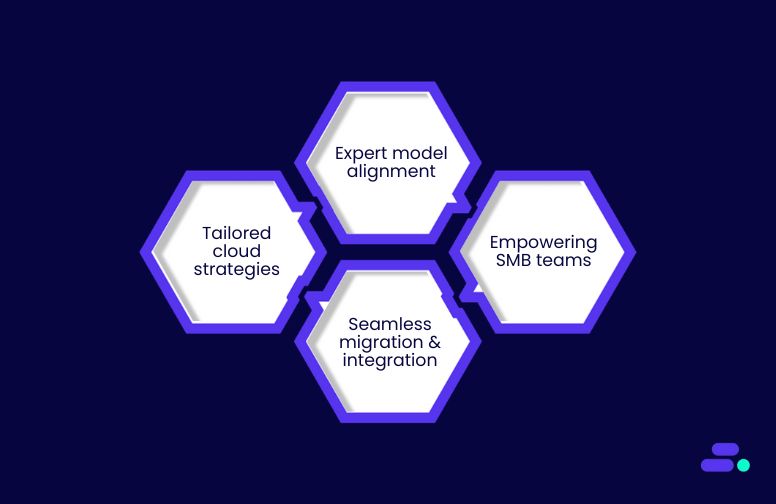
Choosing the right cloud deployment and service models can make or break an SMB’s ability to outmaneuver legacy competitors, but navigating these complex options isn’t easy. That’s exactly why SMBs turn to Cloudtech.
As an AWS Advanced Tier Partner focused on SMB success, Cloudtech brings deep expertise in matching each business with the precise mix of public, private, hybrid, or multi-cloud strategies and service models like IaaS, PaaS, SaaS, and FaaS. They don’t offer one-size-fits-all solutions, but craft tailored cloud roadmaps that align perfectly with an SMB’s technical capacity, regulatory landscape, and aggressive growth ambitions.
Here’s how Cloudtech makes the difference:
- Tailored cloud strategies: Cloudtech crafts customized cloud adoption plans that balance agility, security, and cost-effectiveness, helping SMBs utilize cloud advantages without unnecessary complexity.
- Expert model alignment: By assessing workloads and business priorities, Cloudtech recommends the best mix of deployment and service models, so SMBs can innovate faster and scale smarter.
- Seamless migration & integration: From lift-and-shift to cloud-native transformations, Cloudtech ensures smooth transitions, minimizing downtime and disruption while maximizing cloud ROI.
- Empowering SMB teams: Comprehensive training, documentation, and ongoing support build internal confidence, enabling SMBs to manage and evolve their cloud environment independently.
With Cloudtech’s guidance, SMBs can strategically harness cloud to leapfrog legacy competitors and accelerate business growth.
See how other SMBs have modernized, scaled, and thrived with Cloudtech’s support →

Wrapping up
The cloud’s promise to level the playing field depends on making the right architectural choices, from deployment models to service types. Cloudtech specializes in guiding SMBs through these complex decisions, crafting tailored cloud solutions that align with business goals, compliance requirements, and budget realities.
This combination of strategic insight and hands-on AWS expertise transforms cloud adoption from a technical challenge into a competitive advantage. Leave legacy constraints behind and partner with Cloudtech to harness cloud computing’s full potential.
Connect with Cloudtech today and take the leap toward cloud-powered success.
FAQs
1. How can SMBs manage security risks when adopting different cloud deployment models?
While cloud providers like AWS offer robust security features, SMBs must implement best practices such as encryption, identity and access management, and regular audits. Cloudtech helps SMBs build secure architectures tailored to their deployment model, ensuring compliance without sacrificing agility.
2. What are the common pitfalls SMBs face when migrating legacy systems to cloud service models?
SMBs often struggle with underestimating migration complexity, data transfer challenges, and integration issues. Cloudtech guides SMBs through phased migrations, compatibility testing, and workload re-architecture to minimize downtime and ensure a smooth transition.
3. How can SMBs optimize cloud costs while scaling their operations?
Without careful monitoring, cloud expenses can balloon. Cloudtech implements cost governance tools and usage analytics, enabling SMBs to right-size resources, leverage reserved instances, and automate scaling policies to balance performance and budget effectively.
4. How do emerging cloud technologies like serverless and AI impact SMB cloud strategy?
Serverless architectures and AI services reduce operational overhead and open new innovation avenues for SMBs. Cloudtech helps SMBs identify practical use cases, integrate these technologies into existing workflows, and scale intelligently to maintain competitive advantage.
5. What role does cloud governance play in SMB cloud adoption?
Effective governance ensures policy compliance, data integrity, and security across cloud environments. Cloudtech supports SMBs in establishing governance frameworks, automating compliance checks, and training teams to maintain control as cloud usage expands.

Get started on your cloud modernization journey today!
Let Cloudtech build a modern AWS infrastructure that’s right for your business.

